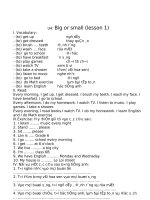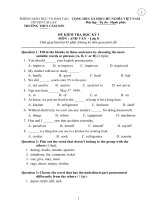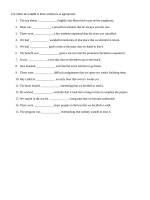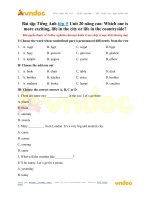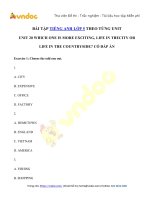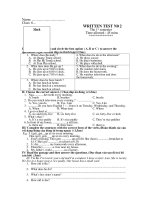Ch08 continuous or distributed
Bạn đang xem bản rút gọn của tài liệu. Xem và tải ngay bản đầy đủ của tài liệu tại đây (781.72 KB, 90 trang )
8 Continuous or distributed
parameter systems
8.1
Introduction
The representation of physical systems by means of discrete models in which
properties like inertia, stiffness and damping are localized and identified with
different elements like masses, springs and dampers is often very convenient
and leads to satisfactory results in many circumstances. In reality, however,
one has to deal with, say, aircraft structures, pipelines, car bodies, various
types of buildings, etc.; in other words, with structures which generally comprise
cables, rods, beams, plates and shells, all of which are neither rigid nor massless.
Every material portion of the system may possess mass, stiffness and damping
properties at the same time, and these properties may vary from point to
point. In these cases, whenever possible, one can resort to continuous models
(we already encountered some examples of such models in Chapters 3 and 5),
where the displacement is a continuous function of both space and time and
we are in presence of an infinite number of degrees of freedom.
Distributed parameter models are based on another idealization: the
continuous elastic medium which, for its part, leads to a fundamental insight
into the nature of mechanical vibrations: the so-called wave-mode duality.
In everyday engineering problems we often tend to think of vibrations in
terms of modes and of, say, acoustical phenomena in terms of waves. As a
matter of fact, this distinction is somehow fictitious because we are just
considering the same physical phenomena: that is, the propagation of a
localized disturbance (mechanical in our case) which ‘spreads’ from one part
of a medium into other parts of the same medium or into a different medium.
We are referring here to the propagation of mechanical waves which, as
a matter of fact, represents a deeper level of explanation for mechanical
vibrations. Normal modes of vibration are in fact particular motions of a
system (for which the system is, let’s say, particularly well suited) which
ensue because of its finite physical dimensions in space and hence because of
the presence of boundaries. In other words, the superposition of travelling
waves reflected back and forth from the physical boundaries of the medium
ultimately result in the appearance of standing waves which, in turn, represent
the normal modes of vibration of our system.
Copyright © 2003 Taylor & Francis Group LLC
This book is primarily concerned with aspects of mechanical vibrations
that do not need a detailed discussion of the ‘wave approach’ and for this
reason the subject of wave propagation and motion in elastic solids will
only be touched on briefly whenever needed in the course of the discussion.
For our purposes, the importance of the considerations above is mostly a
matter of principle, but it must be pointed out that the wave-mode duality
has also significant implications in all fields of engineering where the interest
lies in the study of interactions between sound waves and solid structures.
In essence, distributed parameter systems present many conceptual
analogies with MDOF systems. However, some important differences of
mathematical nature will be clear from the outset. First of all, the motion of
these systems is governed by partial differential equations and, second, these
equations must be supplemented by an appropriate number of boundary
conditions. Moreover, boundary conditions are just as important as the
differential equations themselves and constitute a fundamental part of the
problem; for short, one often says that the motion of a continuous system is
governed by boundary value problems.
These problems are in general much more difficult to solve than their
discrete counterpart (where boundary conditions enter only indirectly because
they are implicitly included into the system’s matrices) and hence, for
continuous systems, exact solutions are available only for a limited number
of cases. We will consider some of these cases and provide the exact solutions.
Nonetheless, for more complex systems we have to resort to approximate
solutions which, in turn, are often obtained through spatial discretization
and in the end—despite the fact that the techniques of analysis may be highly
sophisticated (e.g. the finite-element method)—bring us back to finite-degreeof-freedom systems.
On a more theoretical basis, we pass from the finite-dimensional vector
spaces of the discrete case to infinite-dimensional vector spaces. More
specifically, we have to deal with Hilbert spaces, i.e. infinite-dimensional
vector spaces where an inner product has been defined and are complete
with respect to the norm defined by means of the above inner product. The
reader can find in Chapter 2 some introductory considerations on these
theoretical aspects because it is important to be aware of the fact that the
conceptual analogies with the discrete case rest on the fact that, broadly
speaking, Hilbert spaces are the ‘natural generalization’ of the usual finitedimensional vector spaces.
At the beginning of this chapter we will consider a simple system—the
flexible string—in some detail in order to gain some insight on the
fundamental aspects of wave propagation, natural frequencies and modes
of a continuous system which, with the appropriate modifications, can be
taken as representative for other types of distributed parameter systems.
The beam in bending vibration will be considered next, before turning our
attention to more general aspects of the differential eigenvalue problem and
to the analysis of some two-dimensional systems.
Copyright © 2003 Taylor & Francis Group LLC
8.2
The flexible string in transverse motion
The flexible string under tension—with some basic assumptions that will be
considered soon—is the simplest model of continuous system where mass
and elasticity are distributed over its whole extent. From the discussion
developed in preceding chapters we can argue that, in principle, we could
(and indeed we do) arrive at a satisfactory description of its motion by
considering it as a linear array of oscillators where masses are lumped at
discrete points and elasticity is introduced by means of massless springs
connecting the masses. The greater the number of degrees of freedom, the
better the approximation. Furthermore, we could also work out an asymptotic
solution by increasing the number of masses indefinitely and by letting their
mutual distance tend to zero. However, we adopt a different method of attack
which contains more physical insight than the mathematical expedient of
the limiting procedure; that is, we do not consider the motion of each one of
the individual infinite number of points of the string but only concern
ourselves with the shape of the string as a whole.
So, let us consider a string of indefinite length (we want to avoid for the
moment a discussion of the boundary conditions) which is stretched by a
tension of T0 newtons and whose undisturbed position coincides with the xaxis.
Let us further assume that the displacements of each point of the string are
wholly transverse in a direction parallel to the y-axis. It follows that the string
motion is specified by a ‘shape’ function y(x, t) where x and t play the role of
independent variables: for a fixed time t1 the graph of the function y(x, t1)
depicts the shape of the string at that instant while the graph of the function
Fig. 8.1 Displaced differential element of taut string.
Copyright © 2003 Taylor & Francis Group LLC
fixed—represents the motion of the point located at x1 as time
passes, i.e. the time history of the particle at x1.
Qualitatively, if we assume that any variation of the tension due to the
transverse displacement of the string is negligible, we can apply Newton’s
second law to the differential element of the string shown in Fig. 8.1 to get
the equation of motion in the vertical direction as
(8.1)
where µ (kg/m) is the mass per unit length of the string, which for the present
we assume uniform throughout the length of the string.
If we further assume that the slope of the string is everywhere small—i.e.
or, in other words, the inclination angle θ is always small compared
with one radian, we can write
so that eq (8.1) becomes
(8.2a)
which we can choose to write in the form
(8.2b)
where
has the dimensions of a velocity and, in the approximations
above, is independent of both x and t. Note that the small slopes
approximation (or small-amplitude approximation) expressed by
allows us to neglect all quantities of second and higher order in ∂y/∂x. Only
in this circumstance the net horizontal force on the differential element of
string is zero and we can assume
so that the displacement of each
point is perpendicular to the x-axis and the tension T0 remains unchanged in
passing from point x to point x+dx. When the small slopes assumption ceases
to be valid, the resulting differential equation is nonlinear.
Copyright © 2003 Taylor & Francis Group LLC
Equation (8.2b) is the well-known one-dimensional differential wave
equation which, by assigning the appropriate meanings to the quantities
involved, represents a broad range of wave phenomena in many branches of
physics and engineering (acoustics, electromagnetism, etc.).
Obviously, in our case, the motion ensues because the string has been
disturbed from its equilibrium position (‘plucked’, for example) at some time.
The tension then provides the restoring force but inertia delays the immediate
return to the equilibrium position by overshooting the rest position. Note
also that, for the time being, no consideration whatsoever is given to
dissipative damping forces and to the effect of stiffness that, although
generally negligible, occurs in real strings.
All books on basic physics show that the general solution of the onedimensional wave equation is of the form
(8.3)
which is called the d’Alembert solution of the wave equation. The functions
f and g can be any two arbitrary and independent twice-differentiable
functions whose forms depend on how the string has been started into motion,
i.e. on the initial conditions. It is not difficult to see that f(x–ct) represents a
shape—or a profile—which moves without distortion in the positive xdirection with velocity c, while g(x+ct) represents a similar wave (with a
different shape if
) which moves in the negative x-direction with velocity
c; the linearity of the wave equation implies that if both waveforms have a
finite spatial duration, they can ‘pass through’ one another and reappear
without distortion. Most of us will be familiar with these ‘travelling wave’
phenomena from childhood games with ropes.
8.2.1
The initial value problem
In the case of a string of indefinite length, we can gain some further insight
by considering its motion due to some initial disturbance. This disturbance
is specified by means of the initial conditions, i.e. the functions that determine
the shape and velocity of the string at t=0. Let these functions be
(8.4)
From the general solution, at t=0 we have
(8.5)
Copyright © 2003 Taylor & Francis Group LLC
where the primes represent here the derivatives of the functions f and g with
respect to their arguments. The second of eqs (8.5) can be integrated to give
(8.6)
where the constant of integration C can be set to zero without loss of
generality. From the first of eqs (8.5) and (8.6) it follows
which establish the initial values of the functions f and g. For
the variable x with the appropriate arguments to get
we replace
or, alternatively
(8.7a)
which, by integration of the second term on the r.h.s., i.e.
can be written as
(8.7b)
Equation (8.7b)—which has also been obtained by using transform techniques
in Section 2.3—physically represents identical leftward and rightward
propagating disturbances containing separate contributions from the
displacement and velocity initial conditions.
Copyright © 2003 Taylor & Francis Group LLC
8.2.2 Sinusoidal waves, energy considerations and the presence
of boundaries
Sinusoidal waves
Out of the infinite variety of functions permitted as solutions by the wave
equation (as a matter of fact, any reasonable function of x+ct or x–ct), it
should be expected that sinusoidal waveforms deserve particular attention.
This is because, besides their mathematical simplicity and the fact that many
real-world sources of waves are nearly sinusoidal, we can represent as closely
as desired any reasonable periodic and non-periodic function by the linear
superposition of many sinusoidal functions (Fourier analysis—see Chapter 2
for more details). Mathematically, we can express an ideal sinusoidal wave
of unit amplitude travelling along the string as
(8.8)
where k is the so-called wavenumber: when the quantity kx increases by 2π
the corresponding increment in x is the wavelength so that
or,
equivalently,
Note that, in the light of preceding chapters, the symbols may be a bit
misleading: here k is not a spring constant and
is not an eigenvalue.
However, these symbols for the wavenumber and the wavelength are so
widely used that we adhere to the common usage: the meaning is generally
clear from the context but precise statements will be made whenever some
ambiguities may arise in the course if the discussion.
As far as time dependency is concerned, we already know that the period
T is related to the frequency v by T=1/v and that the angular frequency ω is
given by
the fact that the wave moves to the right can be deduced
by noting that, as time passes, increasing values of x are required to maintain
the phase
constant. Two ‘snapshots’ of the waveform at times t0
and t0+T look exactly the same; this implies that the wave has travelled a
distance in the time interval T so that
(8.9)
Moreover, it is evident that also in this case the exponential representation
(Chapter 1)
(8.10)
is widely adopted and is often very convenient. The wave of eq (8.8) is
obtained by taking the imaginary part of eq (8.10) but, as stated in previous
Copyright © 2003 Taylor & Francis Group LLC
chapters, the real-part convention may be adopted as well, and the difference
is irrelevant as long as consistency is maintained. The general restriction of
small amplitudes
translates for harmonic waves into
or,
in other words, into
(8.11)
which states that the maximum amplitude must be much smaller than the
wavelength. One final word here to point out that the velocity of the
propagation of the disturbance c must not be confused with the velocity of
the individual particles of the string, i.e. with ∂y/∂t; as a matter of fact, for
a general waveform y(x, t)=f(x–ct), since
it follows that the small-amplitude approximation requires
(8.12)
where it must be understood that the string particles move in a transverse
direction while the waveform propagates along the string. The word
‘propagation’ itself, as we shall see shortly, implies a transport of energy and
momentum.
Energy considerations
From the previous discussion, it is apparent that the kinetic energy in a
differential element of string is given by
and the kinetic energy in a segment between x1 and x2 is then
Copyright © 2003 Taylor & Francis Group LLC
which, for small deflections, can be approximated as
(8.13)
The calculation of the potential energy is a bit more involved because second
order terms come into play. The string must possess potential energy because
some external work would have to be done to give it the deflected shape
which, in turn, must locally stretch the string where the wave is present.
This local stretching, however, must excite longitudinal waves that propagate
along the string as well as the transverse waves. The coupling between
longitudinal and transverse waves is expressed by nonlinear terms in the
equation of motion, and precisely these terms is what we want to neglect.
This difficulty can be circumvented by assuming a negligible Young’s modulus
(ideally E=0, i.e. a string which is perfectly flexible). In this hypothesis we
can consider the change in length of a portion of string of initial length dx:
this is
so that the potential energy between x1 and x2 is
(8.14)
because the stretching takes place against a force of tension T0. In the light
of eqs (8.13) and (8.14), it is often convenient to speak of kinetic and potential
energy densities
(8.15)
although these definition have a certain degree of arbitrariness because it is
often difficult—and sometimes meaningless—to keep track of the location
in space and time of a given amount of energy.
Copyright © 2003 Taylor & Francis Group LLC
Two points are worthy of notice at this point:
1. If we consider a general waveform f(x–ct), the kinetic and potential energy
densities are given by
respectively, and since
we see that the two expressions are
equal. Moreover, we can consider a harmonic wave in the exponential
form
—where A is just the amplitude which we assume now to
be different from unity—and calculate the average kinetic and potential
energy densities. Let us consider for example the potential energy density:
we have from eq (8.15)
where the bracket indicates the average over one period. If now we
resort to the phasor convention of Section 1.3, we get
from which it follows that
(8.16)
By the same token, the reader is invited to calculate the average kinetic
energy density, verify that
and arrive at the same result by
considering a harmonic wave in the form of eq (8.8).
2. The equation of motion (8.2) can be obtained by substituting the kinetic
and potential energy densities in eq (3.109) where the Lagrangian density
is given by
In addition, we may be interested in the flux of energy past a given point x;
this rate of energy transfer is just the instantaneous power flow from any
piece of the string to its neighbour. Mathematically, it is obtained as the
product of the vertical component of tension
by the transverse
velocity of the string at x (Fig. 8.1), i.e.
(8.17)
so that a positive value of P (watts) implies power flowing toward the positive
Copyright © 2003 Taylor & Francis Group LLC
x-direction and a negative P means power flowing toward the negative xdirection. For a general travelling wave f(x–ct) we have from eq (8.17)
(8.18)
In the case of a sinusoidal wave, which again we take in the exponential
form of the preceding paragraph, the average power transmitted by the wave
can be obtained from
(8.19)
where, again, the phasor convention of Chapter 1 gives
so that eq (8.19) results in
(8.20)
The calculation of the momentum in the x-direction associated with a
transverse wave that obeys eq (8.2a or b) has to do with the small longitudinal
motion that occurs when a transverse wave is present. We shall not perform
such a calculation here but it can be shown (e.g. Morse and Ingard [1];
Elmore and Heald [2]) that the quantity
(8.21)
may be interpreted as a localized momentum density in the x-direction
associated with a transverse wave. Note that
(8.22)
This is a general relationship connecting energy flow and momentum density
for plane waves travelling in linear isotropic media.
The presence of boundaries
Real strings have a finite length and must be fastened somewhere. This
circumstance affects the motion of the string by imposing appropriate
boundary conditions which—as opposed to the initial conditions of Section
Copyright © 2003 Taylor & Francis Group LLC
8.2.1 which are specified at a given time (usually t=0)—must be satisfied
at all times. Let us suppose that our string is attached to a rigid support
at x=0 and extends indefinitely in the positive x-direction (semi-infinite
string). This is probably the simplest type of boundary condition and it
is not difficult to see that such a ‘fixed-end’ situation mathematically
translates into
(8.23)
for all values of t: a condition which must be imposed on the general solution
f(x–ct)+g(x+ct). The final result is that the incoming wave g(x+ct) is reflected
at the boundary and produces an outgoing wave –g(x–ct) which is an exact
replica of the original wave except for being upside down and travelling in
the opposite direction. The fact that the original waveform has been reversed
is characteristic of the fixed boundary.
Another simple boundary condition is the so-called free end which can be
achieved, for example, when the end of the string is attached to a slip ring
of negligible mass m which, in turn, slides along a frictionless vertical post
(for a string this situation is quite artificial, but it is very important in many
other cases). In physical terms, we can write Newton’s second law stating
that the net transverse force Fy(0, t) (due to the string) acting on the ring is
equal to
Since
and m is negligible, the freeend condition is specified by
(8.24)
which asserts that the slope of string at the free end must be zero at all times.
By enforcing the condition (8.24) on the general d’Alembert solution, it is
now easy to show that the only difference between the original and the
reflected wave is that they travel in opposite directions: that is, the reflected
wave has not been inverted as in the fixed-end case. Note that, as expected,
in both cases—fixed and free end—the incoming and outgoing waves carry
the same amount of energy because neither boundary conditions allow the
string to do any work on the support. Other end conditions can be specified,
for example, corresponding to an attached end mass, a spring or a dashpot
or a combination thereof.
Mathematically, all these conditions can be analysed by equating the
vertical component of the string tension to the forces on these elements. For
instance, if the string has a non-negligible mass m attached at x=0, the
boundary condition reads
(8.25)
Copyright © 2003 Taylor & Francis Group LLC
or, say, for a spring with elastic constant k0
(8.26)
Enforcing such boundary conditions on the general d’Alembert solution
makes the problem somewhat more complicated. However, on physical
grounds, we can infer that the incident wave undergoes considerable distortion
during the reflection process. More frequently, the reflection characteristics
of boundaries are analysed by considering the incident wave as pure harmonic,
thus obtaining a frequency-dependent relationship for the amplitude and
phase of the reflected wave.
8.3 Free vibrations of a finite string: standing waves and
normal modes
Consider now a string of finite length that extends from x=0 to x=L, is fixed
at both ends and is subjected to an initial disturbance somewhere along its
length. When the string is released, waves will propagate both toward the
left and toward the right end. At the boundaries, these waves will be reflected
back into the domain [0, L] and this process, if no energy dissipation occurs,
will continually repeat itself. In principle, a description of the motion of the
string in terms of travelling waves is still possible, but it is not the most
helpful. In this circumstance it is more convenient to study standing waves,
whose physical meaning can be shown by considering, for example, two
sinusoidal waves of equal amplitude travelling in opposite directions, i.e. the
waveform
(8.27a)
which, by means of familiar trigonometric identities, can be written as
(8.27b)
Two interesting characteristics of the waveform (8.27b) need to be pointed
out:
1. All points xj of the string for which sin(kxj)=0 do not move at all times,
i.e. y(xj, t)=0 for every t. These points are called nodes of the standing
wave and in terms of the waveform (8.27a), we can say that whenever
the crest of one travelling wave component arrives there, it is always
cancelled out by a trough of the other travelling wave.
Copyright © 2003 Taylor & Francis Group LLC
2. At some specified instants of time that satisfy
all points x of the
string for which
reach simultaneously the zero position and their
velocity has its greatest value. At other instants of time, when
all the above points reach simultaneously their individual maximum
amplitude value A sin(kx), and precisely at these times their velocity is zero.
Among these points, the ones for which sin(kx)=1 are alternatively crests
and troughs of the standing waveform and are called antinodes.
In order to progress further along this line of reasoning, we must investigate
the possibility of motions satisfying the wave equation in which all parts of
the string oscillate in phase with simple harmonic motion of the same
frequency. From the discussions of previous chapters, we recognize this
statement as the definition of normal modes.
The mathematical form of eq (8.27b) suggests that the widely adopted
approach of separation of variables can be used in order to find standingwave, or normal-mode, solutions of the one-dimensional wave equation.
So, let us assume that a solution exists in the form y(x, t)=u(x)z(t), where
u is a function of x alone and z is a function of t alone. On substituting this
solution in the wave equation we arrive at
which requires that a function of x be equal to a function of t for all x and
t. This is possible only if both sides of the equation are equal to the same
constant (the separation constant), which we call –ω 2. Thus
(8.28)
The resulting solution for y(x, t) is then
(8.29)
where
and it is easy to verify that the product (8.29) results in a
series of terms of the form (8.27b). The time dependent part of the solution
represents a simple harmonic motion at the frequency ω, whereas for the
space dependent part we must require that
(8.30)
Copyright © 2003 Taylor & Francis Group LLC
because we assumed the string fixed at both ends. Imposing the boundary
conditions (8.30) poses a serious limitation to the possible harmonic motions
because we get A=0 and the frequency equation
(8.31)
which implies
(n integer) and is satisfied only by those values of
frequency ωn for which
(8.32)
These are the natural frequencies or eigenvalues of our system (the flexible string
of length L with fixed ends) and, as for the MDOF case, represent the frequencies
at which the system is capable of undergoing harmonic motion. Qualitatively,
an educated guess about the effect of boundary conditions could have led us to
argue that, when both ends of the string are fixed, only those wavelengths for
which the ‘matching condition’
(where n is an integer) applies can
satisfy the requirements of no motion at x=0 and x=L. This is indeed the case
and the allowed wavelengths satisfy
etc.
The first four patterns of motion (eigenfunctions) are shown in Fig 8.2:
the motion for n=1, 3, 5,…result in symmetrical (with respect to the point
x=L/2) modes, while antisymmetrical modes are obtained for n=2, 4, 6,…
So, for a given value of n, we can write the solution as
(8.33)
where, for convenience, the constant of the space part has been absorbed in
the constants An and Bn. Then, given the linearity of the wave equation, the
general solution is obtained by the superposition of modes:
(8.34)
where the (infinite) sets of constants An and Bn represent the amplitudes of the
standing waves of frequency ωn. The latter quantities, in turn, are related to the
allowed wavenumbers by the equation
On physical grounds, since we
observed that there is no motion at the nodes and hence no energy flow between
neighbouring parts of the string, one could ask at this point how a standing
wave gets established and how it is maintained. To answer this question we
must remember that a standing wave represents a steady-state situation; during
the previous transient state (which, broadly speaking, we may call the ‘travelling
wave era’) the nodes move and allow the transmission of energy along the string.
Moreover, it should also be noted that nodes are not perfect in real strings
where friction is present; they are only points of minimum amplitude of vibration.
Copyright © 2003 Taylor & Francis Group LLC
Fig. 8.2 Vibration of a string with fixed ends: (a) first, (b) second mode.
The values of the constants An and Bn can be obtained by imposing the
initial conditions (8.4) on the general solution (8.34). We get
(8.35)
Copyright © 2003 Taylor & Francis Group LLC
Fig. 8.2 Vibration of a string with fixed ends: (c) third and (d) fourth modes.
which we recognize as Fourier series with coefficients A n and ω nBn,
respectively. Following the standard methods of Fourier analysis, we multiply
both sides of eqs (8.35) by sin kmx and integrate over the interval [0, L] in
order to obtain, by virtue of
(8.36)
Copyright © 2003 Taylor & Francis Group LLC
the expressions
(8.37)
which establish the motion of our system. Note that eq (8.34) emphasizes
the fact that the string is a system with an infinite number of degrees of
freedom, where, in the normal mode representation, each mode represents a
single degree of freedom; furthermore, from the discussion above it is clear
that the boundary conditions determine the mode shapes and the natural
frequencies, while the initial conditions determine the contribution of each
mode to the total response (or, in other words, the contribution of each
mode to the total response depends on how the system has been started into
motion). If, for example, we set the string into motion by pulling it aside at
its centre and then letting it go, the ensuing free motion will comprise only
the odd (symmetrical) modes; even modes, which have a node at the centre,
will not contribute to the motion.
A final important result must be pointed out: when the motion is written
as the summation of modes (8.34), the total energy E of the string—i.e. the
integral of the energy density
over the length of the string—is given by
(8.38)
where it is evident that each mode contributes independently to the total
energy, without any interaction with other modes (recall Parseval’s theorem
stated in Chapter 2). The explicit calculation of (8.38), which exploits the
relation (8.36) together with its cosine counterpart
(8.39)
is left to the reader.
Copyright © 2003 Taylor & Francis Group LLC
We close this section with a word of caution. Traditionally, cable vibration
observations of natural frequencies and mode shapes are compared to those
of the taut string model. However, a more rigorous approach must take into
account the axial elasticity and the curvature of the cable (for example, powerline cables hang in a shape called ‘catenary’ and generally have a sag-tospan ratio between 0.02 and 0.05) and may show considerable discrepancies
compared to the string model. In particular, the natural frequencies and mode
shapes depend on a cable parameter
(E=Young’s modulus,
A=cross-sectional area, ρg=cable weight per unit volume, L0=half-span length)
and on the sag-to-span ratio. The interested reader may refer, for example,
to Nariboli and McConnell [3] and Irvine [4].
8.4 Axial and torsional vibrations of rods
In the preceding sections we considered in some detail a simple case of continuous
system—i.e. the flexible string. However, in the light of the fact that our interest
lies mainly in natural frequencies and mode shapes, we note that we can explore
the existence of solutions in which the system executes synchronous motions
just by assuming a simple harmonic motion in time and asking what kind of
shape the string has in this circumstance. This amounts to setting
and substituting it into the wave equation to arrive directly at
the first of eqs (8.28) so that, by imposing the appropriate boundary conditions
(fixed ends), we arrive at the eigenvalues (8.32) and the eigenfunctions
(8.40)
where Cn are arbitrary constants which, a priori, may depend on the index n.
If now we consider the axial vibration of a slender rod of uniform density ρ
and cross-sectional area A in presence of a dynamically varying stress field σ(x, t),
we can isolate a rod element as in Fig. 8.3 and write Newton’s second law as
(8.41)
where y(x, t) is the longitudinal displacement of the rod in the x-direction.
If we assume the rod to behave elastically, Hooke’s law requires that
where
is the axial strain, and upon substitution in
eq (8.41) we get
(8.42)
Copyright © 2003 Taylor & Francis Group LLC
Fig. 8.3 Differential element of a thin rod.
which is the familiar wave equation. Now the wave velocity is given by
(8.43)
where
is the rod mass per unit length.
Alternatively, we could obtain eq (8.42) by writing the Lagrangian density
(eq (3.119)) and by performing the appropriate derivatives required by eq
(3.109). Note that this latter procedure leads also to the boundary conditions
(3.121).
A completely similar line of reasoning leads to the equation of motion for
the torsional vibration of rods which reads
(8.44)
where θ(x, t) is the angle of twist, C is the torsional rigidity of the rod
(which, in turn, depends on the shear modulus G and on the type of crosssection) and J is the polar moment of inertia.
For a circular cross-section C=JG and eq (8.44) becomes
(8.45)
which is again in the form of a wave equation. As for the case of the string,
it should be noted that some simplifying assumptions are implicit in the
development of both eq (8.42) and eq (8.45): these assumptions are considered
in any book on elementary strengths of materials and will not be repeated
here. In the light of the formal analogy of the equations of motion stressed
above, it is evident that, with the appropriate modifications for parameters
Copyright © 2003 Taylor & Francis Group LLC
and physical dimensions, the discussions of the preceding sections apply also
for the cases above.
If now we separate the variables and assume a harmonic solution in time,
we arrive at the ordinary differential equations
(8.46)
where, for convenience, we called u(x) the spatial part of the solution in
both cases (8.42) and (8.45) and the parameter γ 2 is equal to ω 2ρ/E for the
first of eqs (8.46) and to ω 2ρ/G for the second.
Again, in order to obtain the natural frequencies and modes of vibrations
we must enforce the boundary conditions on the spatial solution
(8.47)
One of the most common cases of boundary conditions is the clamped-free
(cantilever) rod where we have
(8.48)
so that substitution in (8.47) leads to
which, in turn, translates into
frequencies are given by
meaning that the natural
(8.49)
for the two cases of axial and torsional vibrations, respectively. Like the
Copyright © 2003 Taylor & Francis Group LLC
eigenvectors of a finite DOF system, the eigenfunctions are determined to
within a constant. In our present situation
(8.50)
where un(x) must be interpreted as an axial displacement or an angle,
depending on the case we are considering.
If, on the other hand, the rod is free at both ends, the boundary conditions
(8.51)
lead to B=0 and
so that
and
(8.52)
are the eigenvalues for the two cases, respectively, while
(8.53)
(where γ n is as appropriate) are the eigenfunctions. Note that in the case of
the free-free rod the solution with n=0 is a perfectly acceptable root and
does not correspond to no motion at all (see the taut string for comparison).
In fact, for n=0 we get
and, from eq (8.46),
so that
where C1 and C2 are two constants whose value is irrelevant
for our present purposes. Enforcing the boundary conditions (8.51) gives
which corresponds to a rigid body mode at zero frequency. As for the discrete
case, rigid-body modes are characteristic of unrestrained systems.
For the time being, we do not consider other types of boundary conditions
and we turn to the analysis of a more complex one-dimensional system—the
beam in flexural vibration. This will help us generalize the discussion on
continuous systems by arriving at a systematic approach in which the
similarities with discrete (MDOF) systems will be more evident.
Copyright © 2003 Taylor & Francis Group LLC
In fact, if now in eq (8.46) we define
replace the differential
operator with a stiffness matrix and the mass density ρ with a mass matrix,
we may note an evident formal similarity with a matrix (finite-dimensional)
eigenvalue problem. Moreover, it is not difficult to note that the same applies
to the case of the flexible string.
8.5
Flexural (bending) vibrations of beams
Consider a slender beam of length L, bending stiffness EI(x) and mass per
unit length µ(x). We suppose further that no external forces are acting.
By invoking the Euler-Bernoulli theory of beams—namely that plane crosssections initially perpendicular to the axis of the beam remain plane and
perpendicular to the neutral axis during bending—and by deliberately neglecting
the (generally minor) contribution of rotatory inertia to the kinetic energy, we
can refer back to Example 3.2 to arrive at the governing equation of motion,
(8.54)
where the function y(x, t) represents the transverse displacement of the beam.
Equation (8.54) is a fourth-order differential equation to be satisfied at every
point of the domain (0, L) and it is not in the form of a wave equation. If,
for simplicity, we also assume that the beam is homogeneous throughout its
length, eq (8.54a) becomes
(8.55a)
or, alternatively
(8.55b)
where ρ is the mass density.
Note that a does not have the dimensions of velocity. We do not enter
into the details of flexural wave propagation in beams, but is worth noting
that substitution of a harmonic waveform
into eq (8.55) leads to
the dispersion relation
and since the phase velocity of wave
propagation is given by
it follows that
(8.56)
Copyright © 2003 Taylor & Francis Group LLC
which shows that the phase velocity depends on wavelength and implies
that, as opposed to the cases of the previous sections, a general nonharmonic
flexural pulse will suffer distortion as it propagates along the beam. Energy,
in this case, propagates along the beam at the group velocity
which can be shown (e.g. Kolsky [5] and Meirovitch [6]) to be related to the
phase velocity by
Furthermore, eq (8.56) predicts that waves of very short wavelength (very
high frequency) travel with almost infinite velocity. This unphysical result is
due to our initial simplifying assumptions—i.e. the fact that we neglected
rotatory inertia and shear deformation—and the price we pay is that the
above treatment breaks down when the wavelength is comparable with the
lateral dimensions of the beam. Such restrictions must be kept in mind also
when we investigate the natural frequencies and normal bending modes of
the beam unless, as it often happens, our interest lies in the first lower modes
and/ or the beam cross-sectional dimensions are small compared to its length.
When this is the case, we can assume a harmonic time-dependent solution
substitute it into eq. (8.55) and arrive at the fourth-order
ordinary differential equation
(8.57)
where we define
We try a solution of the form
which gives
and
and solve the characteristic equation
so that
(8.58)
where the arbitrary constants Aj or Cj (j=1, 2, 3, 4) are determined from
the boundary and initial conditions. The calculation of natural frequencies
and eigenfunctions is just a matter of substituting the appropriate
boundary conditions in eq (8.58); we consider now some simple and
common cases.
Copyright © 2003 Taylor & Francis Group LLC
Case 1. Both ends simply supported (pinned-pinned configuration)
The boundary conditions for this case require that the displacement u(x)
and bending moment
vanish at both ends, i.e.
(8.59)
where, in the light of the considerations of Section 5.5, we recognize that the
first of eqs (8.59) are boundary conditions of geometric nature and hence
represent geometric or essential boundary conditions. On the other hand,
the second of eqs (8.59) results from a condition of force balance and hence
represents natural or force boundary conditions.
Substitution of the four boundary conditions in eq (8.58) leads to
and to the frequency equation
(8.60)
which implies
and hence
(8.61)
The eigenfunctions are then given by
(8.62)
and have the same shape as the eigenfunctions of a fixed-fixed string.
Case 2. One end clamped and one end free (cantilever configuration)
Suppose that the end at x=0 is rigidly fixed (clamped) and the end at x=L is
free; then the boundary conditions require that the displacement u(x) and
slope du/dx both vanish at the clamped end, i.e.
(8.63a)
Copyright © 2003 Taylor & Francis Group LLC

